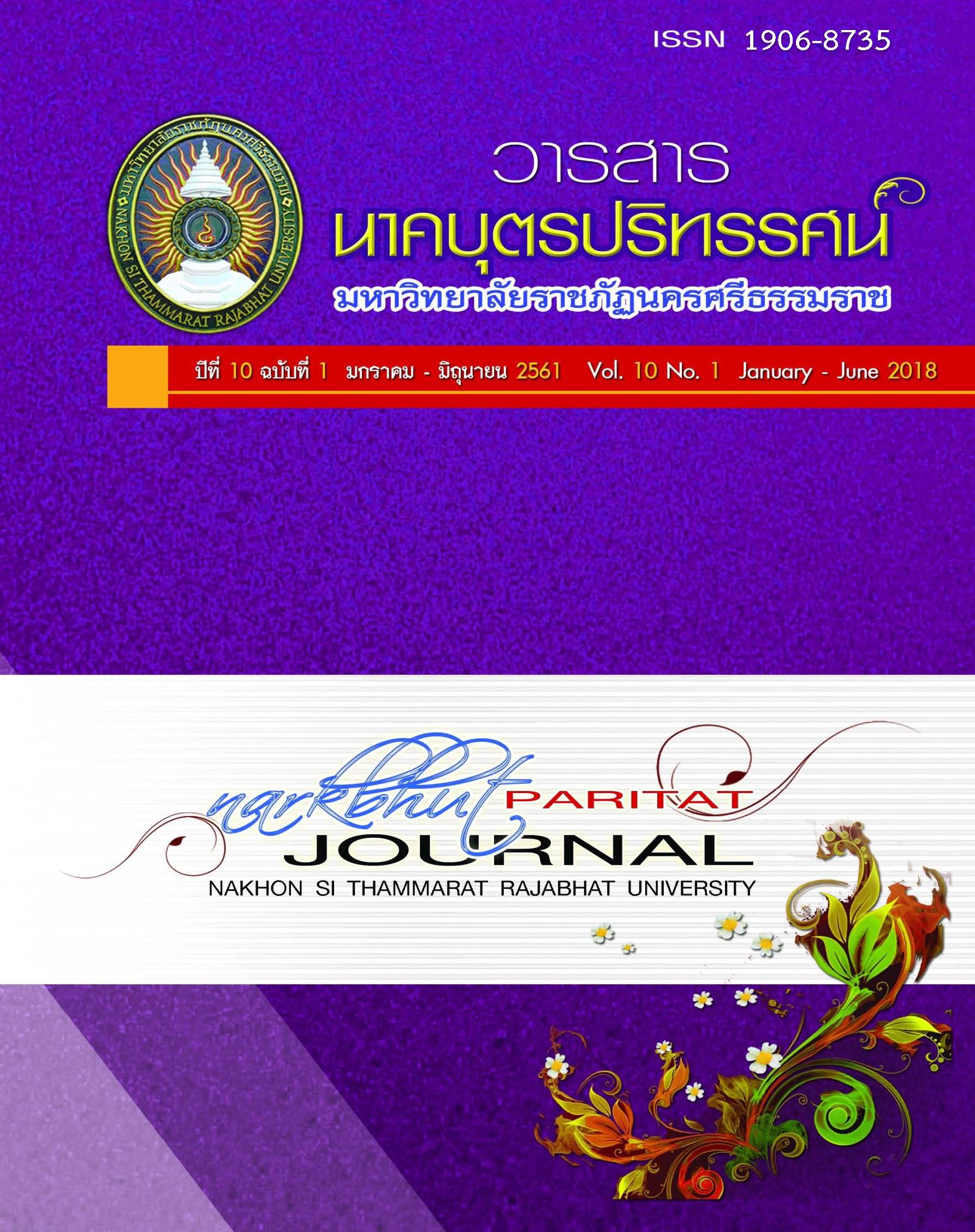การพัฒนาบทเรียนเอ็มเลิร์นนิ่ง เพื่อเสริมสร้างทักษะการอ่าน และการเขียน กลุ่มสาระการเรียนรู้ภาษาไทยสำหรับนักเรียนชั้นประถมศึกษาปีที่ 1 THE DEVELOPMENT OF M –LEARNING LESSON FOR ENHANCING READING AND WRITING SKILLS, SUBSTANCE LEARNING THAI GROUP FOR PRAT
Main Article Content
Abstract
บทคัดย่อ
งานวิจัยเรื่องนี้มีวัตถุประสงค์เพื่อพัฒนาและประเมินประสิทธิภาพของบทเรียนเอ็มเลิร์นนิ่งเพื่อเสริมสร้างทักษะการอ่าน และการเขียน เพื่อทดลองใช้บทเรียนเอ็มเลิร์นนิ่ง เพื่อเสริมสร้างทักษะการอ่าน และการเขียน เพื่อประเมินบทเรียนเอ็มเลิร์นนิ่งเพื่อเสริมสร้างทักษะการอ่าน และการเขียน เพื่อวัดความคงทนทางการเรียนหลังการใช้บทเรียนเอ็มเลิร์นนิ่ง เพื่อเสริมสร้างทักษะการอ่าน และการเขียน กลุ่มสาระการเรียนรู้ภาษาไทยสำหรับนักเรียนชั้นประถมศึกษาปีที่ 1 เป็นการวิจัยและพัฒนา ใช้ระเบียบวิจัยแบบผสานวิธีเชิงปริมาณและเชิงคุณภาพ เครื่องมือวิจัย ได้แก่ แบบวิเคราะห์ข้อมูล แบบสัมภาษณ์ แบบประเมินประสิทธิภาพบทเรียนโดยผู้เชี่ยวชาญ แบบวัดความพึงพอใจ แบบวัดความคงทน สถิติที่ใช้ในการวิเคราะห์ข้อมูลได้แก่ การวิเคราะห์เนื้อหา ร้อยละ ค่าเฉลี่ย ส่วนเบี่ยงเบนมาตรฐาน ความเที่ยงและ สถิติที (t-test dependent )
ผลการวิจัยพบว่า
- บทเรียนเอ็มเลิร์นนิ่งเพื่อเสริมสร้างทักษะการอ่าน และการเขียน กลุ่มสาระการเรียนรู้ภาษาไทยสำหรับนักเรียนชั้นประถมศึกษาปีที่ 1 มี 4 องค์ประกอบดังนี้ 1) ส่วนข้อมูลคำอธิบาย เกี่ยวกับบทเรียน 2) ส่วนจัดการบทเรียน(MLMS) 3)ส่วนจัดการเนื้อหาบทเรียน (CMS) และ 4) ส่วนของการติดต่อกับผู้เรียน ผู้เชี่ยวชาญมีความคิดเห็นเกี่ยวกับบทเรียนเอ็มเลิร์นนิ่งโดยภาพรวมอยู่ในระดับมาก
- บทเรียนเอ็มเลิร์นนิ่งเพื่อเสริมสร้างทักษะการอ่าน และการเขียน กลุ่มสาระการเรียนรู้ภาษาไทยสำหรับนักเรียนชั้นประถมศึกษาปีที่ 1 มีประสิทธิภาพ(E1\E2 ) 75/84.57 ซึ่งมีค่าสูงกว่าเกณฑ์ที่กำหนด (75/75)
- ผลการทดลองใช้บทเรียนเอ็มเลิร์นนิ่งเพื่อเสริมสร้างทักษะการอ่าน และการเขียน โดยนำไปทดลองใช้จริงกับนักเรียนชั้นประถมศึกษาปีที่ 1 โรงเรียนเขาพระทอง ภาคเรียนที่ 2 ปีการศึกษา 2559 จำนวน 21 คน พบว่า
2.1 ทักษะการอ่านหลังเรียนสูงกว่าก่อนเรียนอย่างมีนัยสำคัญทางสถิติที่ .05
2.2 ทักษะการเขียนหลังเรียนสูงกว่าก่อนเรียนอย่างมีนัยสำคัญทางสถิติที่ .05
2.3 ผลสัมฤทธิ์ทางการเรียนหลังเรียนสูงกว่าก่อนเรียนอย่างมีนัยสำคัญทางสถิติที่ .05
- ผลการประเมินบทเรียนเอ็มเลิร์นนิ่งเพื่อเสริมสร้างทักษะการอ่าน และการเขียน พบว่า นักเรียนมีความพึงพอใจต่อบทเรียนเอ็มเลิร์นนิ่งโดยภาพรวมอยู่ในระดับมาก
- ผลการวัดความคงทนทางการเรียนหลังการใช้บทเรียนเอ็มเลิร์นนิ่ง เพื่อเสริมสร้างทักษะการอ่าน และการเขียน พบว่า ความคงทนในการเรียนผ่านไป2 สัปดาห์ไม่แตกต่างจากการทดสอบวัดผลสัมฤทธิ์หลังเรียนอย่างมีนัยสำคัญทางสถิติที่ระดับ .05
คำสำคัญ : บทเรียนเอ็มเลิร์นนิ่ง, ทักษะการอ่าน, ทักษะการเขียน
Abstract
This research aims to to develop and evaluate the effectiveness of M - LEARNING lessons to strengthen reading and writing skills for grade 1 students, to implerment reading skills and writing skills for grade 1 students to evaluate of M- LENAMING curriculum, and 4) to measure grade retention of grade 1 students after using the M - LEARNING lesson. This research used both quantitative and qualitative methods. The research instruments included data analysis, an interview form,satisfaction measurement, a feedback questionnaire, and durability measurement. The statistics used in data analysis included content analysis, percentages, arithmetic mean, standard deviation and t-test dependent.
The results show that
- The M – LEARNING lessons consist 4 components which are 1) descriptive section the lessons 2) lesson management (MLMS) 3) content management (CMS) and 4) When the lessons were inspected by experts, the overall lessons were at a very good level. The effectiveness of the M - LEARNING lessons had Ei (E1/E2) of 75/84,which was more than the criteria standard.
- After using the M - LEARNING lessons, the pre-reading scores were lower than the post-reading scores that were significantly different at .05 levels.
- The results of using the M - LEARNING lesson, the posttest scores of both reading and writing skills were higher than the pretest scores which were statistically significant at the .05 level. Students are satisfied with the M - learning at a high level.
- The retention of students who have studied the M – LEARNING for 2 weels was not significantly different at the.05 level.
Keyword : m-learning, reading skills, writing skills
Article Details
References
Ali Mostakhdemin-Hosseini, Jari Mustajärvi, (2003). FRAMEWORK FOR MOBILE LEARNING SYSTEM
BASED ON EDUCATION COMPONENT. Proceedings of the International Conference on Theory and Applications of Mathematics and Informatics – ICTAMI 2003, Alba Iulia.
Atchara Shewapun. (2011). Creative writing activities in elementary school. Bangkok. Chulalongkorn
University. (in Thai)
Halemor sani. (2010). Development of Computer Assisted Instruction Lesson for Pronunciation
Skills Spelling Section Mae kok,kod and kob. Thesis. Pattani : Prince of Songkla University. (in Thai)
Mantana Khongeid. (2008). A study of status, requirements for using and the mobile learning
network model (m-Learning) for the students of Silpakorn Unviersity. Thesis Silpakorn Unviersity. (in Thai)
Monchai Tienthong. (2005). “M-learning New approach e- Learning” Technology and Communication
Education journal. 1(1). (in Thai)
Nuttagorn songkrom. (2010). Design and development of multimedia for learning. Bangkok :
Chulalongkorn University. (in Thai)
Office of the Basic Education Commission. Annual Report 2005. Office of the Basic Education
Commission. Bangkok : The Agricultural Co-Operative Federation Of Thailand.,LTD.
(in Thai)
Pensri Srisawat.(2012). Development of an M-learning model using knowledge management
strategies. Strengtjening Learning Ouality : Bridging Engineering and Education.Bangkok.
(in Thai)
Pongnarin Lertrungporn. (2004) The development of mobile computer assisted instruction
package on PDA. Thesis Information Technology. King Mongkut's Institute of
Technology North Bangkok. (in Thai)
Sarod Sopeeruk. (2014, November 2014 - April 2015 ). M-learning. Journal of Bangkokthonburi
University. 3(2). (in Thai)
Siwagan Patumsud. (2011). I can not read it easily. Suphan Buri : Thungsak-ar-som Learning
Center. (in Thai)
Supang Jantawanit. (2007). Qualitative Research Methodology. Printed at 15. Chulalongkorn
University. (in Thai)
Thatchapon Teedee, (2016, July - December) An Achievement of Research Methodology
Learning on Basic Pubilc. Administration Titled “Peer Assisted Learning” Nagabut Joural Revew, 8(2). NaKhon Si Thommarat. Nakhon Si Thammarat Rajabhat University. . (in Thai)
Thongchai Kaewkiriya. (2009). E-Learning Move on to the M - learning in the social sphere of
boundless communication. [Online]. Available :http://research.krirk.ac.th/story/2 [2012,
August 24]. (in Thai)
Wijan Panit. (2012). 21st Century Learning Path for Disciples. Bangkok. Sodsri – Saritwong
foundation. (in Thai)
WiWat mesuwan. (2008). Development of wireless teaching aids on personal digital assistants.
(PDA). Srinakharinwirot University. (in Thai)
Yuttana Nunlaoog and Orlanut Nunlaoog. (2011). Development of Internet-based lessons
cellphone (M-LEARNING) on the digestive tract. Anatomy and Physiology II For the first year nursing students, Boromarajonani College of Nursing, Chainat. (in Thai)


